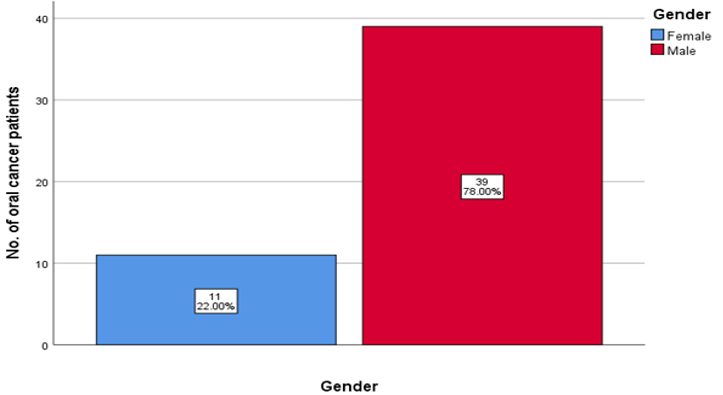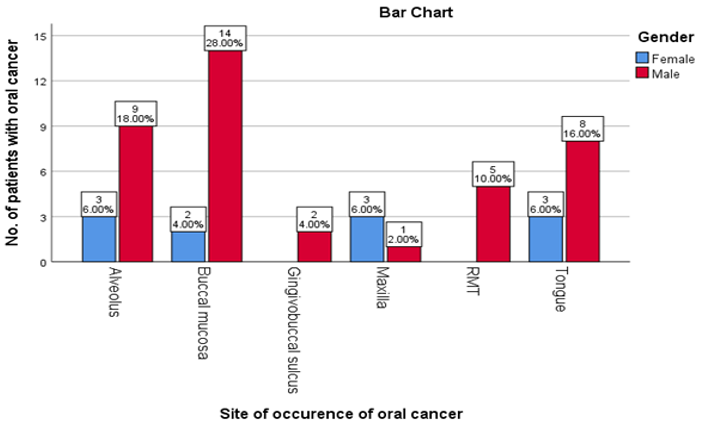Gender predilection in oral cancer - A university based study
Abstract
Oral cancer is said to be a malignant neoplasm of the oral cavity. It is defined as the uncontrollable growth of cells that invade and cause damage to the surrounding tissues. Oral cancer has a predilection for certain sites, most common being the lips, followed by the tongue, cheeks, floor of the mouth, hard and soft palate, sinuses, and pharynx. In general, a high male to female ratio of occurrence of oral cancer is seen. The main risk factors for oral cancer are smoking, alcohol, gutkha, paan and other factors such as cheek biting and sharp cusps also seem to influence the occurrence of oral cancer. The study aims at assessing the gender of patients who have been diagnosed with oral cancer to see if there is any predilection for oral cancer based on gender to occur. The study was done in a University set up in a Private Dental College, Chennai. This study was done retrospectively by analysing case records of patients who reported between the months of June 2019 to March 2020. Simple random sampling was done to minimize sampling bias. After reviewing, the case sheets were filtered based on the data required. The final sample size was 50 patients with oral cancer. The data pertaining to the gender of the patient was collected. It was observed that from those 50 patients with oral cancer, 78% of them were males and 22% of them were female. Chi-square test shows p>0.05, not significant. The study concludes that the males were affected more than females.
Keywords
Gender, Oral cancer, Prevalence, Risk factors
Introduction
Oral cancer is a malignant neoplasm which occurs on the lips and oral cavity (Lingen, 2008). In dentistry, various treatment procedures are done to treat dental problems (Patturaja & Pradeep, 2016). Management of Oral cancer is said to be one challenging entity among various treatments that are being done in the field of dentistry. 90% of the cancers histologically originate from squamous cells. After the patient is diagnosed with oral cancer, he is first staged for better treatment planning. It has a propensity for lymph-node metastasis (WHO, 2005).
From previous studies, it is seen that the male to female ratio of patients with oral cancer is rapidly declining (Reddy, Cundall-Curry, & Bridger, 2010). But still, in regions of no development and in some western countries, it is found that this ratio is stable (Sanderson, 1997). In other countries, one of the main reasons for the rapid decline in this ratio is the increased exposure of tobacco and alcohol to women. Some researchers find women to be more susceptible to the effect of tobacco (Risch, 1993). Dental anxiety and anxiety-related avoidance of dental care create significant problems for the patients and dental practitioners (Azhar, 2018). Thus most of the patients with oral cancer fail to report to the clinic at an early stage itself.
Head and neck cancer is ranked third among the most common malignancies in both the genders. Oral cancer is a subtype of head and neck cancer. Each year over 45,000 patients have been diagnosed with oral cancer (Mishra & Meherotra, 2014). The study about the geographical distribution of oral cancer states that it is more prevalent in Asian countries particularly in the South and Southeast Asia (Mishra & Meherotra, 2014; Rao, 2013). It is also observed that there is a higher incidence of oral cancer among younger patients (Ghantous & Elnaaj, 2017). The oral habits that are addictive and cause oral cancer are most commonly associated with males. Certain studies also claim that cancer can be hormone influenced (Suba, 2007). Rural areas have been reported with more cases because of the lack of awareness and knowledge. The oral adverse habits are addictive and influence the younger age groups which can cause lesions at an early age (Baumeister, 2017).
When analysing the challenges faced by other researchers, it is seen that most of them analysed the disease with the possible risk factors alone and failed to consider the influence of gender. In the case of oral cancer, long term follow up is essential, just like how the incidence of alveolar osteitis was recorded for seven days (Jesudasan, Wahab, & Sekhar, 2015). Our team is working on studies that can aid in further advancements (Jain, 2019; Marimuthu, 2018) and studies that would be of great scope in future (Christabel et al., 2016; Marimuthu, 2018) and has also conducted various knowledge-based surveys (Abhinav, Selvarasu, Maheswari, & Taltia, 2019; Rao & Kumar, 2018) and studies (Kumar & Sneha, 2016), clinical studies (Kumar, 2017), various awareness-based studies (Abhinav, Sweta, & Ramesh, 2019; Kumar, 2017) knowledge-based studies (Kumar & Rahman, 2017) that have been put forth over the past five years. Now we are focussing on retrospective studies. The idea for the present study stemmed from the current interest in our community. The aim of the study is to assess the presence or absence of any association between gender and oral cancer.
Materials and Methods
Study Setting
This retrospective study was based on data collected from the patient records of a Private Dental College and Hospitals. Records of patients who reported between the months of June 2019 to March 2020 were reviewed. Approval was obtained from the institutional Scientific Review Board. Two examiners were included in the study.
Sampling
Cross verification of data for error was done by additional reviewers and by photographic evaluation. Simple random sampling was done to minimize sampling bias. After reviewing, the case sheets were filtered based on data required. The final sample size was 50 patients with oral cancer. The inclusion criteria were patients with oral cancer. The exclusion criteria were patients without oral cancer, patients with premalignant conditions and patients whose case records were incomplete.
Data collection
The data was entered in the system in a methodical manner. The data was entered in excel manually and imported to SPSS for analysis.
Analytics
IBM SPSS Software [Version 19: IBM corporation NY USA] was used for data analysis. Descriptive statistics which included frequency of distribution was used for the analysis. The independent variables were age, gender. Chi-square test was performed. The level of significance was set at 0.05.
Results and Discussion
The data was imported to SPSS version 19 and the results were obtained using the chi-square test. From the study, it was observed that males were more affected than females. Out of 50 patients, it was seen that 78% [39 patients] were males and 22% [11 patients] were females [Figure 1]. It was seen that among the male patients 28% of them had lesions on the buccal mucosa, 18% on the alveolus, 16% on the tongue, 4% on gingivobuccal sulcus and 2% on the maxilla. Among the female patients, 6% had lesions on the alveolus, tongue and maxilla and 4% on the buccal mucosa [Figure 2]. The p-value was found to be non-significant [0.087].


It is seen that out of 50 patients, 39 patients [78%] were males and 11 patients [22%] were females. Dentists being the first to encounter any changes in the oral cavity, have the responsibility to counsel, diagnose and effectively treat the disease at the initial stage of the disease (Kruse, 2011). Recently, there has been an increase in the incidence in the occurrence of oral cancer among female patients, as shown by Reddy et al. (Reddy et al., 2010). It is also seen that the recurrence rate is higher in males.
The most common risk factor of oral cancer is found to be alcohol and tobacco, and other factors like cheek biting, chronic irritation from the sharp tooth can lead to the formation of non-healing ulcers and further lead to the development of cancer. Sharp cusps present in the tooth causes discontinuity of the mucosa which is present adjacent to it and thus can lead to the progression of cancer of the tongue. Other habits like paan and gutka chewing were also found to be significantly associated with patients diagnosed with oral cancer. Bross and Coombs presumed that exposure of women to both alcohol and tobacco causes a downward shift in the age of onset of oral cancer (Bross & Coombs, 1976). A study demonstrated an incidence of 48.5% of tobacco use and 34.5% of alcohol usage in females (CDC, 2012). In addition, it was observed that the awareness level about basic dental procedures was apparently good among the general population (CDC, 2012; Petersen, 2004). Majority of the women suffered from oral cancer than from cancer of the hypopharynx cancer (Kruse, Bredell, & Grätz, 2011).
In recent studies, a high number of oral maxillary carcinomas [hard palate and maxillary alveolar ridge] in women were striking [23 females, 16 male] (Kumar, 2013). It was also observed that the higher male to female ratio of squamous cell carcinoma was seen without any possible risk factors (Kruse, Bredell, & Grätz, 2010). Certain studies have claimed that certain types of cancer can be induced by hormones which causes a particular gender (females) to become susceptible to the disease (Dallenbach, 1980; Kruse et al., 2010). The incidence of oral cancer is highly associated with the age of the patient as well (Sharma, 2018). Some studies also state that the incidence of occurrence of oral cancer was more in males, but females had higher mortality (Dorak & Karpuzoglu, 2012; Sharma, 2018). Women who tend to smoke are at a higher risk of being affected by oral cancer but still certain studies emphasise that males are at higher risk due to higher association with adverse habits or rather more frequency in the usage of these risk factors.
The management of oral cancer was similar to the management of ranula initially that is done by surgical method (Packiri, 2017). Gender was said to influence pain and it is well known that female patients tend to get more anxious. Studies also state that preoperative dental anxiety is a major reason for the pain experienced by patients during dental extractions. Hence, it is important to reduce anxiety before starting any treatment in order to reduce pain perception of the patient during the treatment (Kumar, 2017).
Reconstruction is essential for patients who have undergone surgical management to remove the primary tumour as most patients tend to be esthetically concerned or rather require restoration of their functional requirements. When looking into the interposition materials for replacement after excision, the buccal fat pad graft proved to give better results as the interposition material as it has good patient acceptance, rapid epithelization, minimal donor site morbidity and minimal intra and postoperative complications (Kumar, 2017; Patil, 2017).
Though the present study is in accordance with previous literatures, the limitations faced in the study was the smaller sample size and the results cannot be extrapolated to a larger population because of geographical limitations.
Conclusion
Within the limitations of the study, it was observed that the majority of the patients who reported with oral cancer were males. It was seen that among the male patients 28% of them had lesions on the buccal mucosa, 18% on the alveolus, 16% on the tongue, 4% on gingivobuccal sulcus and 2% on the maxilla. Among the female patients, 6% had lesions on the alveolus, tongue and maxilla and 4% on the buccal mucosa. This might be due to the lack of awareness among the general population as well. An oral cancer awareness programme should be conducted among the general population and should involve educating the patient on risk factors of oral cancer and counselling of such patients is warranted to reduce the mortality rate.
Acknowledgement
The study was supported by the University, who provided insights and expertise that greatly assisted the study. We would also like to thank the reviewers of the article for their insights.
Funding Support
The authors declare that they have no funding support for this study.
Conflict of Interest
The authors declare that they have no conflict of interest for this study.